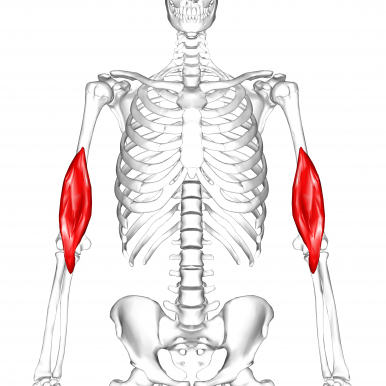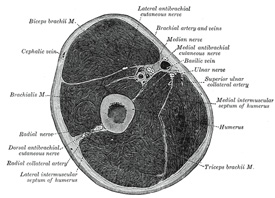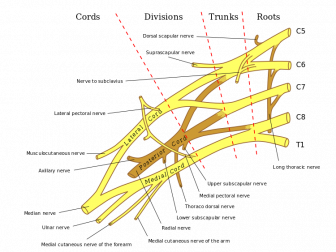Brachialis: Difference between revisions
Matthew Chin (talk | contribs) No edit summary |
Matthew Chin (talk | contribs) No edit summary |
||
| Line 15: | Line 15: | ||
=== Nerve === | === Nerve === | ||
The brachialis muscle is innervated by the [[Musculocutaneous Nerve|musculocutaneous]] nerve and components of the [[radial nerve]]. The radial nerve descends in the groove between the brachialis and [[brachioradialis]] muscles, above the elbow. Of the muscles in the anterior compartment, the biceps brachii and the brachialis are innervated by C5 and C6 nerve roots.<ref name=":1">Gray, Henry. 1918. Anatomy of the Human Body [Internet]. [cited 2018 Mar 21]. Available from: <nowiki>http://www.bartleby.com/107/</nowiki> | The brachialis muscle is innervated by the [[Musculocutaneous Nerve|musculocutaneous]] nerve and components of the [[radial nerve]]. The radial nerve descends in the groove between the brachialis and [[brachioradialis]] muscles, above the elbow. Of the muscles in the anterior compartment, the biceps brachii and the brachialis are innervated by C5 and C6 nerve roots.<ref name=":1">Gray, Henry. 1918. Anatomy of the Human Body [Internet]. [cited 2018 Mar 21]. Available from: <nowiki>http://www.bartleby.com/107/</nowiki> | ||
</ref>[[File:Brachial-plexus-2.png|thumb|336x336px]] | </ref>[[File:Brachial-plexus-2.png|thumb|336x336px]]<div class="pp-no-course-suggestions pp-no-article-suggestions"></div> | ||
== Summary == | |||
Description: image of a vertebra | |||
Source: Modified Illustration from Anatomy & Physiology, Connexions Web site. http://cnx.org/content/col11496/1.6/ | |||
== Licensing == | |||
{{Template:Cc-by-sa-3.0}} | |||
=== Artery === | === Artery === | ||
Revision as of 21:53, 28 September 2020
Top Contributors - Eric Henderson, Matthew Chin, Kirenga Bamurange Liliane, Kim Jackson, Joao Costa and Wendy Snyders
Description[edit | edit source]

The brachialis muscle is the primary flexor of the elbow. This muscle is located in the anterior compartment of the arm along with the Biceps brachii and coracobrachialis.
Origin[edit | edit source]
Distal anterior aspect of the humerus, deep to the biceps brachii.[2]
Insertion[edit | edit source]
Coronoid process and the ulnar tuberosity.[2]
Nerve[edit | edit source]
The brachialis muscle is innervated by the musculocutaneous nerve and components of the radial nerve. The radial nerve descends in the groove between the brachialis and brachioradialis muscles, above the elbow. Of the muscles in the anterior compartment, the biceps brachii and the brachialis are innervated by C5 and C6 nerve roots.[3]
Summary[edit | edit source]
Description: image of a vertebra Source: Modified Illustration from Anatomy & Physiology, Connexions Web site. http://cnx.org/content/col11496/1.6/
Licensing[edit | edit source]
This file is licensed under the Creative Commons Attribution-Share Alike 3.0 Unported license.
You are free:
- to share
- to copy, distribute and transmit the work to remix
- to adapt the work
Under the following conditions:
- attribution – You must attribute the work in the manner specified by the author or licensor (but not in any way that suggests that they endorse you or your use of the work).
- share alike – If you alter, transform, or build upon this work, you may distribute the resulting work only under the same or similar license to this one.
Artery[edit | edit source]
Muscular branches of brachial artery, recurrent radial artery.[2]
Function[edit | edit source]
The brachialis muscle has a large cross sectional area, providing it with more strength than the biceps brachii and the coracobrachialis.[4] In order to isolate the brachialis muscle the forearm needs to be in pronation, due to the biceps brachii's function as a supinator and flexor.[4] By pronating the forearm the biceps is put into a mechanical disadvantage.

Clinical relevance[edit | edit source]
The brachialis muscle can be commonly injured by repetitive forceful contractions or muscular contractions with the arm in hyperextension. This is commonly seen in climbers, due to the pronation of the hand and the extended started position.[5] Physical activity that involve a lot of pull ups, curls, and rope climbing can also initiate brachialis muscle pain.[6] A strain to the brachialis tendon can also cause a patient to present with lacking elbow extension due to painful end-range stretching of the tendon. Due to the location of the pain, medial epicondylitis and lateral epicondylitis should also be evaluated.
The brachialis acts as the floor of the cubital fossa[3], and is part of the radial tunnel. It may be implicated in Erb's palsy if the Brachial plexus becomes injured, leading to elbow flexion weakness.
Video[edit | edit source]
Assessment[edit | edit source]
To assess the strength of the brachialis place the elbow at 90 degrees of flexion with the forearm fully pronated. Then have the patient resist an inferior force placed on the distal forearm.[7]
Resources[edit | edit source]
- ↑ Anatomography. English: Brachialis muscle. [Internet]. 2013 [cited 2018 Mar 21]. Available from: https://commons.wikimedia.org/wiki/File:Brachialis_muscle11.png
- ↑ 2.0 2.1 2.2 Brachialis [Internet]. [cited 2018 Mar 21]. Available from: https://rad.washington.edu/muscle-atlas/brachialis/
- ↑ 3.0 3.1 3.2 Gray, Henry. 1918. Anatomy of the Human Body [Internet]. [cited 2018 Mar 21]. Available from: http://www.bartleby.com/107/
- ↑ 4.0 4.1 Marieb EN, Hoehn K. Human anatomy & physiology. 10th ed. Boston, Ma: Pearson; 2016.
- ↑ Bond T. Tom’s Physiotherapy Blog: “Climber’s elbow” - Brachialis Tendonitis [Internet]. Tom’s Physiotherapy Blog. 2013 [cited 2018 Mar 21]. Available from: http://thomasbondphysio.blogspot.com/2013/06/climbers-elbow-brachialis-tendonitis.html
- ↑ Brachialis muscle pain & trigger points [Internet]. [cited 2018 Mar 21]. Available from: https://www.muscle-joint-pain.com/trigger-points/trigger-point-self-treatment/brachialis/
- ↑ Muscolino JE. Kinesiology: the skeletal system and muscle function. 2nd ed. St. Louis, MO: Mosby/Elsevier; 2011.







